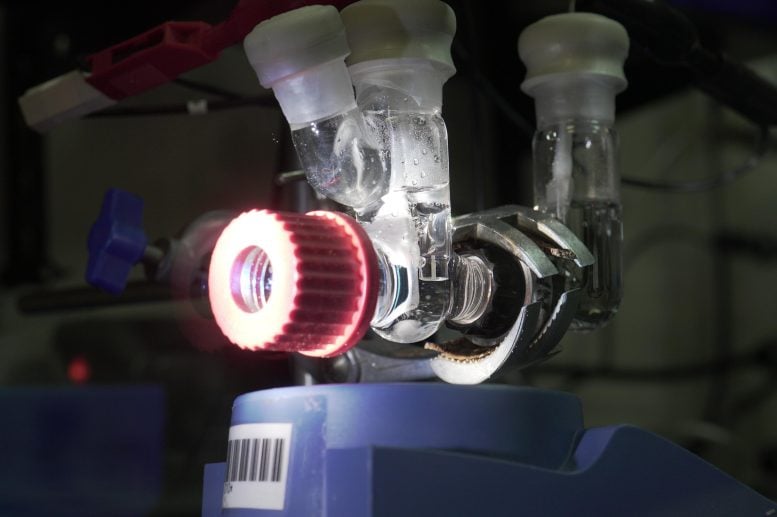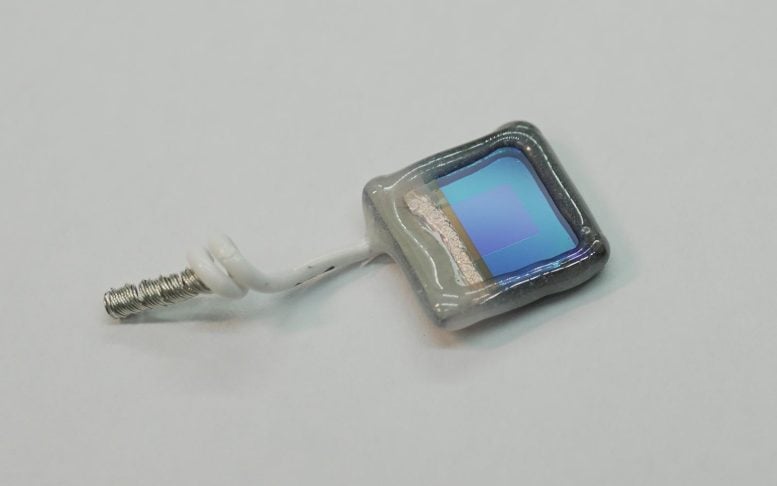
Posted on 11/04/2025 8:15:20 AM PST by Red Badger

Semi-artificial organic photocathode in operation. Credit: Celine Yeung
Researchers at Cambridge have developed a solar-powered device that imitates photosynthesis to turn CO2, sunlight, and water into valuable chemical fuels.
Their non-toxic “semi-artificial leaf” can run continuously and efficiently, producing pharmaceutical compounds with high purity. The discovery could help replace fossil fuels in chemical manufacturing and spark a new era of green chemistry.
Sustainable Chemistry Breakthrough
Scientists have found a sustainable new method for producing the essential chemicals that make up thousands of products we use every day, including plastics and cosmetics.
The global chemical industry manufactures an enormous range of compounds by transforming raw materials, most often fossil fuels, into finished goods. Because of its vast scale and reliance on these carbon-heavy resources, the sector is responsible for around 6% of global carbon emissions.
Now, a team led by the University of Cambridge is working on innovative techniques that could eventually “de-fossilize” this crucial industry and make chemical production far more sustainable.
The Semi-Artificial Leaf
The researchers have designed a hybrid system that joins light-absorbing organic polymers with bacterial enzymes to transform sunlight, water, and carbon dioxide into formate—a clean fuel that can drive other chemical reactions.
This “semi-artificial leaf” imitates photosynthesis, the natural process plants use to capture and store solar energy, and it operates entirely without an external power supply. Unlike earlier versions that relied on unstable or toxic materials, this new biohybrid model is safer, more durable, and doesn’t require additional additives that can reduce performance.

Semi-artificial organic photocathode. Credit: Celine Yeung
Turning CO2 Into Valuable Chemicals
During testing, the team successfully used sunlight to convert carbon dioxide into formate and then applied that formate directly in a “domino” sequence of reactions to create an important pharmaceutical compound, achieving impressive yield and purity.
Their results, reported in the journal Joule, mark the first time that organic semiconductors have been used as the light-harvesting component in this type of biohybrid device, opening the door to a new family of sustainable artificial leaves.
The chemical industry is central to the world economy, producing products from pharmaceuticals and fertilizers, to plastics, paints, electronics, cleaning products, and toiletries.
“If we’re going to build a circular, sustainable economy, the chemical industry is a big, complex problem that we must address,” said Professor Erwin Reisner from Cambridge’s Yusuf Hamied Department of Chemistry, who led the research. “We’ve got to come up with ways to de-fossilize this important sector, which produces so many important products we all need. It’s a huge opportunity if we can get it right.”
A Cleaner Approach to Artificial Photosynthesis
Reisner’s research group specializes in the development of artificial leaves, which turn sunlight into carbon-based fuels and chemicals without relying on fossil fuels. But many of their earlier designs depend on synthetic catalysts or inorganic semiconductors, which either degrade quickly, waste much of the solar spectrum, or contain toxic elements such as lead.
“If we can remove the toxic components and start using organic elements, we end up with a clean chemical reaction and a single end product, without any unwanted side reactions,” said co-first author Dr. Celine Yeung, who completed the research as part of her PhD work in Reisner’s lab. “This device combines the best of both worlds – organic semiconductors are tuneable and non-toxic, while biocatalysts are highly selective and efficient.”
The new device integrates organic semiconductors with enzymes from sulfate-reducing bacteria, splitting water into hydrogen and oxygen or converting carbon dioxide into formate.
Cracking the Enzyme Stability Puzzle
The researchers have also addressed a long-standing challenge: most systems require chemical additives, known as buffers, to keep the enzymes running. These can break down quickly and limit stability. By embedding a helper enzyme, carbonic anhydrase, into a porous titania structure, the researchers enabled the system to work in a simple bicarbonate solution — similar to sparkling water — without unsustainable additives.
“It’s like a big puzzle,” said co-first author Dr. Yongpeng Liu, a postdoctoral researcher in Reisner’s lab. “We have all these different components that we’ve been trying to bring together for a single purpose. It took us a long time to figure out how this specific enzyme is immobilized on an electrode, but we’re now starting to see the fruits from these efforts.”
“By really studying how the enzyme works, we were able to precisely design the materials that make up the different layers of our sandwich-like device,” said Yeung. “This design made the parts work together more effectively, from the tiny nanoscale up to the full artificial leaf.”
Record Efficiency and Durability
Tests showed the artificial leaf produced high currents and achieved near-perfect efficiency in directing electrons into fuel-making reactions. The device successfully ran for over 24 hours: more than twice as long as previous designs.
The researchers are hoping to further develop their designs to extend the lifespan of the device and adapt it so it can produce different types of chemical products.
“We’ve shown it’s possible to create solar-powered devices that are not only efficient and durable but also free from toxic or unsustainable components,” said Reisner. “This could be a fundamental platform for producing green fuels and chemicals in future – it’s a real opportunity to do some exciting and important chemistry.”
Reference:
“Semi-artificial leaf interfacing organic semiconductors and enzymes for solar chemical synthesis”
by Celine Wing See Yeung, Yongpeng Liu, David M. Vahey, Samuel J. Cobb, Virgil Andrei, Ana M. Coito, Rita R. Manuel, Inês A.C. Pereira and Erwin Reisner, 10 October 2025, Joule.
DOI: 10.1016/j.joule.2025.102165
The research was supported in part by the Singapore Agency for Science, Technology and Research (A*STAR), the European Research Council, the Swiss National Science Foundation, the Royal Academy of Engineering, and UK Research and Innovation (UKRI). Erwin Reisner is a Fellow of St John’s College, Cambridge. Celine Yeung is a Member of Downing College, Cambridge.
Why do certain people think they can replace something better than what God already created?
I kinda thought O2 was useful, but what do I know?
It’s called a tree.
I just use it for breathing ....................
Always an interesting observation how mankind always has and always is, constantly trying to fabricate mechanical means that imitate nature. Trying to match God I suppose one could say...
How about oxygen? I real trees do it better.
but the real leaves need the CO2
Very useful.

When they remove all the CO2 they’ll find out WE NEED CO2 to survive ,LOL
What about wood? And O2?
Leaves are self generated and self recycled 🤷🏼♂️
The entire effort to rid the industry of carbon depends on...wait for it...CARBON.

Have you seen the price of diamonds lately?
You can get ‘lab created’ diamonds cheap as hell...............
To think it all started with a semi-permeable, non-nutritive cereal varnish.
Now look where we are today!
“You can get ‘lab created’ diamonds cheap as hell...............”
there are no diamonds in hell, carbon burns

Well there we go- now we can take out the CO2 and plunge right into another ice age
Disclaimer: Opinions posted on Free Republic are those of the individual posters and do not necessarily represent the opinion of Free Republic or its management. All materials posted herein are protected by copyright law and the exemption for fair use of copyrighted works.